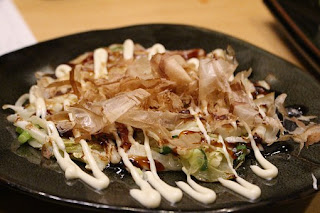 |
| katsuobushi - www.healthnote25.com |
Katsuobushi (鰹 節) is a preserved food made from raw tuna
(katsuo). Katsuobushi is shriveled into wood shavings to be taken as the basic
ingredients of Japanese cuisine, sprinkled on top of the food as flavored, or
eaten as a rice-eater.
Katsuobushi which has been thin, light
brown to pink slightly clear is generally sold in plastic packaging.
Katsuobushi as a flavoring food is usually sprinkled on top of hiyayako (cold
tofu), okonomiyaki and takoyaki. Katsuobushi which has been called penyzut
kezuribushi.
Skipjack preservation into katsuobushi
is common in some countries such as Japan and the Maldives. The technique of
fish preservation into katsuobushi has been known in Japan since before the Edo
period. Katsuobushi is also called wooden fish because the tuna that has been
processed to be very hard as wood, so before use should be shaved with a tool
of crabs.
The fish is split into 2 parts to remove
the bones, leaving a fish-shaped curve like a ship called fushi (節). The meat of the fish is then processed so that the product is finally
called katsuobushi.
Processing consists of various stages,
the designation for skipjack tuna that is only boiled and dried is namaribushi.
The next stage is to process namaribushi by fumigation or evaporation to
cultivate the types of molds on the surface. The end product often used in
Japanese cuisine is katsuobushi which is experiencing the expanse and
namaribushi.
Katsuobushi is rich in vitamin B complex
and contains many inosine and umami elements so it is always used in Japan as a
herb or seasoning. In Japanese terms, umami is a "delicious" flavor
that is an added flavor of the four main common flavors: sweet, sour, salty,
and bitter.
Katsuobushi result is called karebushi (枯 節) which contains more umami and vitamin B than usual katsuobushi.








0 Comments:
Post a Comment